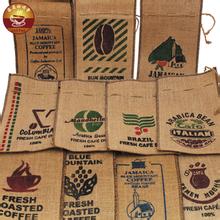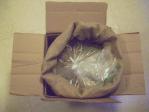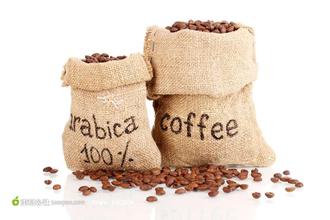Packaging of coffee beans: what bag is the most suitable for packaging coffee beans?

Cloth bags that pack coffee beans can choose to use cloth bags made of environmentally friendly materials, such as linen bags and cotton bags. In general, conventional packaging, especially overseas merchants like to use jute cloth to pack. Jute is not only environmentally friendly and recyclable, but also can print a variety of Peugeot. It is both beautiful and practical.
As coffee beans naturally produce carbon dioxide after roasting, direct packaging is easy to cause packaging damage, and long-term contact with air will cause aroma loss and lead to the oxidation of oil and aromatic components in coffee. Therefore, the packaging of coffee beans (powder) is particularly important.
The choice of cloth bag is for the most primitive packing method.
Raw beans are generally packed in gunny bags. Different coffee producing countries around the world usually export coffee beans in sacks of 70 kilograms or 69 kilograms (only Hawaiian coffee is packed in 100 pounds). In addition to the names of the country and its coffee organizations, coffee production units, and producing areas, the coffee sacks will also print the most typical patterns of their own countries on the sacks. These seemingly ordinary commodity sacks, in the eyes of coffee fans, has become a footnote to explain the background of coffee culture. It has even become a collection of many coffee fans, and this kind of packaging can be called the original packaging of coffee. Now the latest packaging methods are as follows: roasted coffee beans (powder) packaging is generally divided into bagged and canned.
(1)。 Bagging: bagging is generally divided into: non-airtight packaging, vacuum packaging, one-way valve packaging, pressure packaging. Non-airtight packaging: it is actually a temporary package and is only used for short-term storage. Vacuum packaging: roasted coffee beans need to be placed for a period of time and then packaged to prevent carbon dioxide damage to the packaging, this kind of packaging can generally be stored for about 10 weeks. One-way valve packaging: adding an one-way valve to the bag allows the removal of carbon dioxide but will block the entry of external gas, ensuring that coffee beans are not oxidized but can not prevent the loss of aroma. This kind of packaging can be stored for up to 6 months. There are also some coffee using exhaust hole packaging, that is, only making exhaust holes on the bag without adding an one-way valve, so that once the carbon dioxide produced by coffee beans is emptied, the external air will enter the bag, resulting in oxidation, so its storage time will be greatly reduced. Pressurized packaging: coffee beans are vacuum packed soon after baking and sealed with inert gas. this kind of packaging can ensure that coffee beans are not oxidized, aroma will not be lost, and there is enough strength to ensure that the packaging will not be damaged by air pressure. can be stored for up to two years.
(2)。 Canning: the cans are generally of two types: metal and glass, both of which are equipped with plastic lids for easy sealing. Instant coffee packaging instant coffee packaging is relatively simple, generally using sealed small bags, currently mainly packed in long strips, but also have an outer packing box. Of course, there are also some canned instant coffee on the market.
Important Notice :
前街咖啡 FrontStreet Coffee has moved to new addredd:
FrontStreet Coffee Address: 315,Donghua East Road,GuangZhou
Tel:020 38364473
- Prev

Packaging of raw coffee beans: an analysis of the secret of raw bean labels: what is meant by "GP"
There is a lot of information on the label of raw coffee beans. In addition to clear information at a glance, such as altitude and how to handle it, there are also some common English abbreviations that sometimes take a little thought. GP, refers to a way of packaging raw beans, GrainPro, special packaging for grains. When raw coffee beans are exported from the place of production, they are packed in gunny bags, which is already familiar to most coffee lovers. But,
- Next

Introduction to the packaging of coffee beans, the materials used in packaging and the differences in color
According to the form of coffee supply, coffee packaging can be divided into three categories: raw bean export packaging, roasted coffee bean (powder) packaging, instant coffee packaging. Ethiopia Maral coffee packaging atlas 1, raw bean export packaging: raw bean packaging is generally used in gunny bags. Different coffee producing countries in the world usually export coffee beans in 70kg or 69kg packages (only Xia Wei
Related
- What is the meaning of lactic acid fermentation with coffee bean treatment?
- How to judge the state of foam by sound?
- How does the latte pull out the unicorn pattern? Come to get for a little trick to improve the flower pull!
- Will flower pulling affect the taste of the latte?
- Do you know the history of coffee?
- The difference between honey treatment and sun washing what is raisin honey treatment?
- What kind of milk can a novice use to make coffee foam to keep the foam longer? The correct method and skills of milking tutorial sharing
- Why do washed coffee beans taste sour? Flavor characteristics of washed Coffee
- Introduction to the skill of how to practice the size and height of water injection around the circle of hand-brewed coffee
- How do beginners practice coffee flower drawing from scratch?

